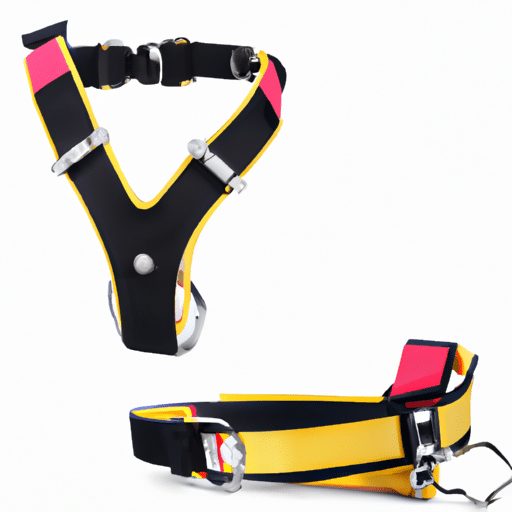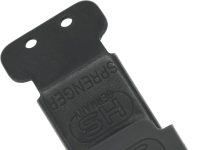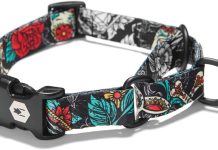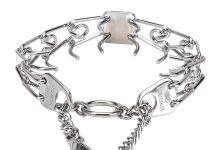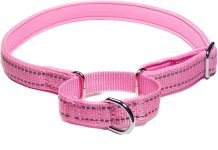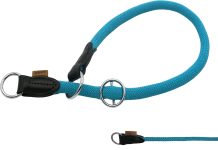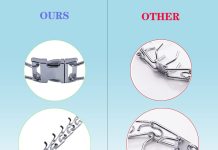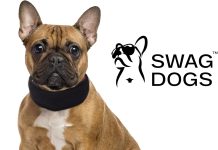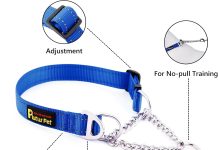Dog owners are often on the lookout for the safest harness for their beloved furry friends. With the overwhelming number of options available in the market, it can be a daunting task to navigate through the various styles and features. However, fear not! In this article, we will uncover the key factors to consider when choosing a safe harness for your dog, providing you with the necessary information to make an informed decision. Say goodbye to the days of worry and uncertainty, as we guide you towards ensuring your dog’s comfort and safety on every adventure.
Factors to Consider
When it comes to choosing the safest harness for your dog, there are several factors you need to consider. These factors include the size and breed of your dog, the type of harness, the material and durability, as well as the comfort and fit of the harness.
Table of Contents
Size and breed of the dog
The size and breed of your dog play a crucial role in determining the type of harness that is safest for them. Small dogs, such as Chihuahuas or Dachshunds, may require a different type of harness compared to larger breeds like German Shepherds or Great Danes. It is important to choose a harness that is proportionate to your dog’s size and one that provides optimal support.
Type of Harness
There are several types of harnesses available in the market, each designed to serve different purposes and provide varying levels of safety. Some common types include step-in harnesses, back-clip harnesses, front-clip harnesses, and dual-clip harnesses. Understanding the advantages and disadvantages of each type can help you make an informed decision and choose the safest option for your dog.
Material and Durability
The material and durability of a harness are important factors to consider when it comes to the safety of your dog. Look for harnesses made from high-quality materials that are sturdy and have good tensile strength. Nylon and polyester are popular choices for their durability and water-resistant properties. Additionally, make sure the hardware, such as buckles and clips, are strong and securely attached to the harness.
Comfort and Fit
A comfortable and properly fitted harness is essential for your dog’s safety and well-being. A harness that is too tight can cause discomfort or restrict movement, while a loose harness may lead to the dog slipping out. Look for harnesses with adjustable straps that allow for a customized fit and ensure that the harness is snug but not overly tight. Comfort features like padded straps can also enhance your dog’s experience while wearing the harness.
Different Types of Dog Harnesses
There are various types of dog harnesses available, each designed to suit different needs and preferences. Understanding the differences between these types can help you choose the safest harness for your dog.
Step-in Harness
A step-in harness is designed for easy and quick putting on and taking off. As the name suggests, your dog simply steps into the harness, and it is secured around their body. Step-in harnesses are popular for their simplicity and are generally suitable for small to medium-sized dogs.
Back-clip Harness
Back-clip harnesses have a leash attachment at the back of the dog’s shoulders. This type of harness is ideal for dogs that have a tendency to pull or those who require more control during walks. Back-clip harnesses distribute the force evenly across the dog’s body, reducing strain on the neck and throat.
Front-clip Harness
Front-clip harnesses have a leash attachment at the front of the dog’s chest. This type of harness is effective in redirecting your dog’s pulling force, as it encourages them to turn towards you rather than pulling straight ahead. Front-clip harnesses are commonly recommended for dogs that tend to lunge or pull during walks.
Dual-clip Harness
Dual-clip harnesses have both a front and back leash attachment, providing versatility and control. This type of harness allows you to choose between the front and back attachment points based on your dog’s behavior and training needs.
Popular Harness Brands
Now that we have explored the different types of dog harnesses, let’s take a look at some popular brands known for their quality and safety.
Kurgo Tru-Fit Smart Harness
The Kurgo Tru-Fit Smart Harness is a highly regarded product known for its durability and safety features. It has a padded chest plate for added comfort and adjustable straps to ensure a snug fit. The harness also features a back-clip design and includes a seatbelt tether for car rides, making it a versatile option for both walks and travel.
Ruffwear Front Range Harness
The Ruffwear Front Range Harness is another top-rated harness that prioritizes safety and comfort. It has a sturdy construction and features both front and back leash attachment points for increased control. The harness also includes reflective trims for enhanced visibility during nighttime walks.
EzyDog Chest Plate Harness
The EzyDog Chest Plate Harness is a popular choice among dog owners for its ergonomic design and safety features. The chest plate is padded to distribute the force evenly across the dog’s chest, reducing strain on the neck and back. The harness also has adjustable straps for a customized fit and includes a reflective trim for added visibility.
Julius-K9 IDC Powerharness
The Julius-K9 IDC Powerharness is a harness well-known for its strength and durability. It features a sturdy handle on the back, allowing for better control and lifting assistance when needed. The harness also has reflective elements and adjustable chest and belly straps for a secure and comfortable fit.
Safety Features to Look for
When selecting a harness for your dog, it is essential to consider the safety features it provides. Here are some important safety features to look for:
Reflective Trims
Harnesses with reflective trims enhance your dog’s visibility during low-light conditions, such as early morning or evening walks. This feature is especially important if you live in an area with heavy traffic or frequently walk in dimly lit areas.
Sturdy Construction
A harness with sturdy construction ensures that it can withstand the pulling force exerted by your dog without breaking or coming apart. Look for harnesses made from high-quality materials and reinforced stitching for added strength and durability.
Secure Buckles and Clips
The buckles and clips on the harness should be secure and reliable to prevent accidental openings or breakage. Check for harnesses with high-quality hardware, such as metal buckles and robust plastic clips, that can withstand regular wear and tear.
Padded Straps
Padded straps provide additional comfort and prevent rubbing or chafing on your dog’s skin. Look for harnesses with soft padding on the chest, back, and straps to ensure your dog’s comfort during walks or adventures.
Adjustable Design
An adjustable harness allows for a customized fit that ensures both safety and comfort for your dog. Look for harnesses with multiple adjustable points, such as chest and belly straps, to achieve the perfect fit for your dog’s body shape and size.
Importance of Proper Fit and Measurement
Ensuring that the harness fits your dog properly is crucial for their safety and overall well-being. A poorly fitted harness can lead to discomfort, rubbing, or even choking hazards. Here are some important aspects to consider regarding proper fit and measurement of a dog harness.
Measuring Your Dog for a Harness
Measuring your dog accurately is the first step towards finding the right-sized harness. Start by measuring your dog’s chest girth, which is the circumference just behind their front legs. Use a soft tape measure and make sure it is snug but not tight. Refer to the manufacturer’s sizing guide to determine the appropriate harness size for your dog based on their measurements.
Avoiding Choking and Rubbing
A harness that is too tight can constrict your dog’s breathing and movement, leading to choking hazards. On the other hand, a harness that is too loose may allow your dog to slip out or cause rubbing and discomfort. Ensure the harness fits snugly but allows room for your dog to move comfortably and breathe easily.
Checking for Proper Adjustment
After putting the harness on your dog, check for proper adjustment. The harness should be positioned high on the chest, just behind the shoulders, and the straps should be neither too tight nor too loose. Ensure that you can fit two fingers comfortably between your dog and the harness to ensure a proper and secure fit.
Common Mistakes to Avoid
When choosing a harness for your dog, it’s important to avoid common mistakes that could compromise their safety and well-being. Here are some mistakes to steer clear of:
Using a Collar Instead of a Harness
Using a collar instead of a harness can put unnecessary strain on your dog’s neck and throat, especially if they are prone to pulling. A harness distributes the pulling force across the dog’s chest and shoulders, reducing the risk of injuries and discomfort.
Not Checking for Choking Hazards
Failure to check for choking hazards can result in a dangerous situation for your dog. It’s important to ensure that the harness is properly adjusted and not too tight around the neck area. Regularly check the harness for any signs of wear and tear, such as frayed or stretched straps, and replace it if needed.
Using an Ill-Fitting Harness
An ill-fitting harness can cause discomfort, rubbing, or even lead to your dog slipping out. It is crucial to measure your dog accurately and choose a harness that fits them properly. Additionally, regularly check the fit of the harness and make any necessary adjustments as your dog grows or if they gain or lose weight.
Frequently Asked Questions
When should I use a dog harness?
A dog harness should be used whenever you take your dog for a walk, especially if your dog tends to pull or has respiratory issues. Harnesses provide better control and distribute the pulling force, reducing the risk of injuries to your dog’s throat and neck.
How do I know if my dog’s harness is too tight?
If your dog’s harness is too tight, they may exhibit signs of discomfort, restlessness, or difficulty breathing. You can check if the harness is too tight by ensuring that you can fit two fingers comfortably between the harness and your dog’s body.
Can I leave a harness on my dog all day?
While it is generally safe to leave a properly fitted harness on your dog during the day, it is recommended to remove the harness during rest periods or when your dog is unsupervised. This allows your dog’s skin to breathe and prevents any potential rubbing or discomfort that may occur from wearing the harness continuously.
Conclusion
Choosing the right harness for your dog is essential for their safety, comfort, and overall well-being. Consider factors such as the size and breed of your dog, the type of harness, the material and durability, as well as the comfort and fit. Look for harnesses from reputable brands that prioritize safety features, such as reflective trims, sturdy construction, secure buckles and clips, padded straps, and adjustable designs. Remember to measure your dog accurately, avoid common mistakes, and regularly check the fit and condition of the harness. By taking these factors into account, you can ensure that your furry friend is properly protected and comfortable during walks and adventures.

